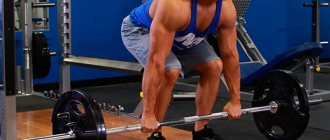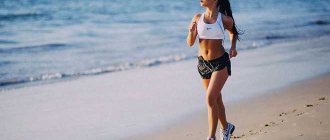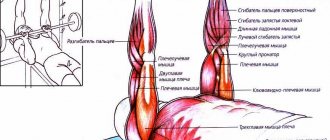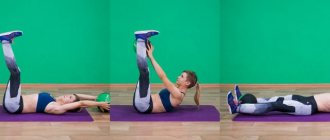Exercise No. 1
Perform body lifts very smoothly, without jerking. Do not rise too high or lie completely on the floor. The abdominal muscles should be constantly tense. The arms work parallel to the body. Don't try to pull yourself up with your neck. If you feel like you're having a hard time, don't get too low.
Perform four sets of eight repetitions.
Ballerina exercises for quick weight loss of legs
To begin with, I would like to advise everyone to practice well in front of a mirror, take your time and master breathing with all the important details. Remember: if it’s easy for you, then you’re doing something wrong. Oxysize breathing, if done correctly, will require a lot of effort from you, and it should be difficult for you, and only when you start adding. It is known that there is one joy in life - to eat tasty and fun.
These exercises promote rapid weight loss. It is recommended to perform on an empty stomach or an hour after eating. Ballerinas and dancers sometimes need to lose weight quickly; to do this, many of them do intense twenty-minute exercises every day. It is recommended to perform the exercises on an empty stomach or an hour after eating. To practice, you will need a jump rope, you will have to jump a lot, so you need to exercise in a special sports bra that supports your breasts.
But usually this joy is overshadowed by the sight of a round, expanding belly. My friend says: “I just feel how every pie is deposited on my waist.”
Losing weight in the legs - a set of exercises for ballerinas and not only
When ballerinas and dancers need to get their figure in order as soon as possible, they use the following one-minute set of exercises, which should be performed either on an empty stomach or an hour after eating: For ballerina exercises to lose weight in your legs, you will need jump ropes. Since these workouts are based on jumping, it is important to start training in a special sports bra that supports the breasts.
Take the jump ropes in your hands and jump over them on two legs for 3 minutes. Land on your entire foot, because by stepping on your toes, you will pump up your legs, but they will not lose weight.
Continue jumping, but now put your legs forward one at a time. Do the exercise for 2 minutes.
Exercise No. 3
Starting position - legs bent at the knees, feet resting on the floor, body raised above the floor. When performing side crunches, first lift your body, then lower it down and at the same time rotate to the side. Return to the starting position and do the same with a twist in the other direction. The press is in constant tension. Keep your hands in front of you. Don't strain your neck while lifting.
Perform four sets of eight repetitions.
Exercises for BALLERINS: easy gait, strong back, great mood
Author Editorial Board Pravda.Ru
27.04.2004 08:05
Health » Beauty » Fitness
Every woman dreams of emphasizing the advantages of her figure. Therapist at the Perm Opera and Ballet Theater named after P. I. Tchaikovsky, Andrei Grigorievich OLENEV, believes that morning exercises with elements of choreographic movements are the most effective. It helps tone your muscles, promotes a great mood and keeps you in great physical shape.
Ballerinas are always distinguished by a light gait, a strong back, a proud carriage of the head, and swift movements. It has been noticed that ballet dancers, despite the grueling work in their youth, live long, and in old age retain vigor of body and clarity of thought. Before working in the theater, I had no idea how much work, dedication, and effort is required to flutter like a light-winged sylph or swim out like a proud swan girl.
In ballet, there is a law of strict dependence between daily exercises (the so-called professional “exercise” of ballet dancers) and problems of the musculoskeletal system. Ballet dancers who ignore exercises doom themselves to inevitable injuries. Moreover, women experience injuries much more often than men. It is impossible to repeat a ballet exercise, but I am sure that morning exercises with elements of classical ballet training help balance physical condition and mood.
You need to do this gymnastics for at least 30 minutes and at a calm rhythm. Of course, the time can be reduced, but remember: after five minutes of physical activity only the skin warms up, after ten - the subcutaneous tissue, after twenty - the muscles, and only after half an hour the body is completely ready for activity. All proposed exercises can be alternated, addressing each several times. Turn on melodic (preferably your favorite) music... and start.
1. Exercise for the head and neck. Stretch your neck, feel its entire long line. Contracting the muscles of the right and left half of the neck alternately, turn your head left and right. The face is raised, the muscles of the neck and chest are pleasantly tense. The eyes follow the direction the head moves.
2. Work on your back. Straight posture is the main law of performing exercises. Starting position: facing the support. Holding the back of a chair or the bar of a wall bars at chest level, turn and lower your shoulders, draw in your buttocks and stomach. Feel the spine as your support, your core. Try to feel a rectangle located in one plane, the corners of which are the shoulders and hip bones. It’s easy to check the correct position of your back - release the support and lift one leg. If your back is positioned correctly, you will not lose your balance.
3. Combine exercises 1 and 2. Later, without losing your posture, slowly move your legs to the side one by one, transferring the center of gravity to the supporting leg.
4. Slowly rise up onto your high toes (don’t forget about your back). Heels together, toes as far apart as possible. This exercise strengthens the Achilles tendon, calf, gluteal and thigh muscles, develops the arch of the foot, and fights flat feet. In just a week you will feel how easy it is to walk in heels, swelling has decreased, and your feet will not ache in the evening. By the way, this exercise, repeated day after day, is an excellent prevention of varicose veins.
5. Squat. In ballet this movement is called plie. The starting position is the same: facing the support. The center of gravity of the body is distributed evenly on both legs. Heels together, toes apart. The knee is pointed towards the toes. It is unacceptable to fall on the outer or inner parts of the foot. Squatting and straightening occur evenly, without jerking. Having slowly reached the limit point below, you cannot linger in this position. Squatting and lifting are a single smooth (cantilena) movement. Continuity and softness of movements make the muscles elastic, a calm rhythm does not interfere with breathing.
6. Body tilts. Standing facing the support, slowly tilt your body to the right. Raise your left arm in a soft semicircle above your head, turned to the right. The right shoulder does not go down, the left does not go up. Having tilted the body to the extreme point, return to the starting position at the same slow pace.
7. Leg raises. You “throw” your leg with a push to a height accessible to you. A straight body and a strong back do not cause any involuntary shudders.
The main principle of this gymnastics is the work of all muscle groups: head, back, legs. The smoothness of the basic movements seems to “awaken” the body, instilling strength and accelerating the blood. If your goal is weight loss, you can add the necessary exercises or supplement your complex with some elements of ballet exercises.
Natalia ARKHIPOVA "Women's health"
Topics spine
Discuss
Exercise No. 4
Sitting on the floor, lean your body back a little and place your hands on the floor. Raise your legs, tighten your abs and start turning invisible pedals, alternately pulling your knees to your chest. When one knee is pulled towards the chest, the other leg straightens and lowers down, but does not touch the floor. The lower one leg goes and the closer the knee of the second leg is pulled to the chest, the greater the load.
Perform four sets of eight repetitions.
You can try a more difficult option - without relying on your hands.
Exercise No. 5
Lie on your back. The legs are bent at the knees and resting on the floor with the toes at a distance of the feet from the buttocks. The arms are extended along the body. The stomach is pulled in. Raise your pelvis off the floor as high as possible and straighten your right leg. Then bend it again and lower your pelvis down.
Complete four sets of eight repetitions on one leg and move on to the next exercise.
How does a ballerina live?
At 10-11 am, all ballet dancers are already waiting in the rehearsal hall. Regardless of the type of performance or the level of the dancer herself, a ballerina must learn every day. The higher the level of the theater, the more experienced and demanding the teachers, the higher the competition and the more difficult the selection. Beginning artists, in order to prove their readiness to learn, often come an hour before the start of the lesson itself - they pre-warm up their joints and muscles, practice complex pirouettes so as not to fall in the eyes of the master.
At the school, girls and boys train separately, while the whole group trains together during work. Dancers in pairs practice lifts, paired elements and excerpts from classical ballet works. Constant practice is the key to a successful career.
Regardless of the artist’s employment in the play, he needs to take “classes” in the morning. These are classical classes where dancers practice stances and basic ballet elements at the barre on their own. Movements at the machine are honed to perfection in front of a mirror. Then the dancers repeat the movements without support, trying to maintain stable posture and graceful movements of their arms and legs. After this, the artists repeat basic jumps and techniques. The most experienced ones remain in pointe shoes for the entire lesson, others put them on only to practice the dance movements themselves.
Only after classes do girls and boys go to rehearsals for their own productions, practicing excerpts from works for 8-10 hours. After all, ballet is the beauty of details, grace at your fingertips. Rough movements are not allowed. The most difficult pirouettes should seem something natural and effortless to the audience. And behind it all are dance hall blisters and challenging workouts.
Young ballerinas often limit themselves to get-togethers with friends and even dates, finding a match right in the ballet hall. After all, after rehearsals at 10 pm, the only energy left is for sleep and rest.
Exercise No. 7
Sit on the mat with your feet together. Tilt your body back slightly and place your hands on the floor, palms facing forward. Lift your pelvis off the floor, pull in your stomach and begin to spring your arms, bending them slightly, as if you were doing partial reverse triceps push-ups.
Perform four sets of eight repetitions.










